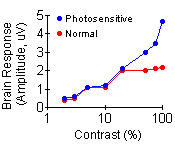 |
Pokemon on the Brain |  |
|
March 11, 2000 Pokemon is the popular Japanese cartoon show that has swept across the world. Is watching Pokemon dangerous to your health? In 1997, one episode caused some serious problems for viewers in Japan and now scientists have an idea why. | ||
Pokemon (episode #38) Packs a PunchOn the evening of December 16, 1997, millions of people all over Japan gathered in their homes to watch Pokemon (episode #38). About 20 minutes into the program there was a scene of a rocket explosion that flashed red and blue lights at a rate of about 12 times per second. This explosion scene was mixed with about five seconds of flashing lights
from the eyes of "Pikachu," a popular Pokemon character. Suddenly,
viewers started to complain of blurred vision, headaches, dizziness and
nausea. Some people even had seizures, convulsions and lost
consciousness. A total of 685 children (310 boys, 375 girls) were taken
to hospitals by ambulances. Although many children recovered during the
ambulance trip, more than 150 of them were admitted to hospitals. Two
people stayed in the hospital for over 2 weeks!
This explosion scene was mixed with about five seconds of flashing lights
from the eyes of "Pikachu," a popular Pokemon character. Suddenly,
viewers started to complain of blurred vision, headaches, dizziness and
nausea. Some people even had seizures, convulsions and lost
consciousness. A total of 685 children (310 boys, 375 girls) were taken
to hospitals by ambulances. Although many children recovered during the
ambulance trip, more than 150 of them were admitted to hospitals. Two
people stayed in the hospital for over 2 weeks! |  JAPAN |
The Cause and Solution Scientists believe that the flashing
lights triggered "photosensitive seizures" in which
visual stimuli such as flashing lights can cause altered consciousness.
Although scientists know that approximately 1 in 4000 people (0.5
- 0.8% of children between 4-14 years old) are susceptible to these types
of seizures, the number of people affected by this Pokemon episode was
unprecedented.
Scientists believe that the flashing
lights triggered "photosensitive seizures" in which
visual stimuli such as flashing lights can cause altered consciousness.
Although scientists know that approximately 1 in 4000 people (0.5
- 0.8% of children between 4-14 years old) are susceptible to these types
of seizures, the number of people affected by this Pokemon episode was
unprecedented.
New Experiments from Italy
 Italian scientists have detailed an abnormal brain response
to flashing lights in people who suffer from photosensitive seizures.
For both normal volunteers (average age, 15.2 years) and photosensitive
volunteers (average age, 18 years), they examined the brain's electrical
response to changing light patterns. The researchers found that in normal
volunteers, as the flickering lights increased in contrast, the response
of the brain increased. At high contrast levels, the brain's response
leveled out. The brain response in photosensitive people also increased
with higher contrasts, but it did not level out at
the highest contrast levels (see figure on the right; data adapted from
Porciatti et al., 2000). This was especially apparent when the lights
flashed at rates between 4 and 10 times per second. The scientists
believe that the brains of photosensitive people have a defective or
absent mechanism that controls the reaction to visual information. This
may have caused the seizures associated with the Pokemon episode
(#38). Italian scientists have detailed an abnormal brain response
to flashing lights in people who suffer from photosensitive seizures.
For both normal volunteers (average age, 15.2 years) and photosensitive
volunteers (average age, 18 years), they examined the brain's electrical
response to changing light patterns. The researchers found that in normal
volunteers, as the flickering lights increased in contrast, the response
of the brain increased. At high contrast levels, the brain's response
leveled out. The brain response in photosensitive people also increased
with higher contrasts, but it did not level out at
the highest contrast levels (see figure on the right; data adapted from
Porciatti et al., 2000). This was especially apparent when the lights
flashed at rates between 4 and 10 times per second. The scientists
believe that the brains of photosensitive people have a defective or
absent mechanism that controls the reaction to visual information. This
may have caused the seizures associated with the Pokemon episode
(#38). |
 |
If you have absolutely no idea what Pokemon is all about, visit the official Pokemon Web Site. |
|
References and further information:
|
 Soon after this unfortunate incident, Japanese television broadcasters and
medical officials got together to find ways to make sure this never
happened again. They established the following guidelines for future
animated programs:
Soon after this unfortunate incident, Japanese television broadcasters and
medical officials got together to find ways to make sure this never
happened again. They established the following guidelines for future
animated programs:![[email]](./gif/menue.gif)
![[newsletter]](./gif/menunew.gif)
![[search]](./gif/menusea.gif)
